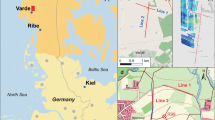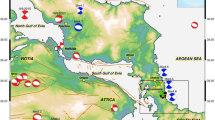Abstract
The two seismic units, i.e., the basement and the basin sediments are interpreted as Miocene and Plio-Quaternary deposits, respectively. The basin sediments of approximately 255 m thickness are risen and compressed through the active strike-slip faults, GF1–GF3 extending in N–S direction towards the outer Gülbahçe Bay. These compressed sediments are interpreted as upwelling zones with weak reflection character and internal frequency attenuation. The most significant one is marked as a possible mud diaper zone with a ~320 m width and the approximately 500 m. A synthetic model of the field data gathered from the diaper indicates that the top of the diapir is characterised by a strong positive reflection character while the internal diaper is represented by polarity reversals and weak reflections due to a velocity decrease with depth. Moreover, phase changes are observed at the border of the diapiric structure. A relatively thicker basin sediment unit of approximately 700 m was observed on the pro-delta sediments of the Gediz River and the sediments below in the İzmir Gulf. The active strike-slip faults, İF1–İF5 deform the basement and basin deposits. Moreover, two active normal faults, İF6 and İF7 are marked from inner to outer part of the gulf. The seismic attribute sections indicate weak reflection zones and frequency attenuation particularly both inside the pro-delta sediments and the sediments below. Observations suggest to us the existence of possible fluid and/or gas discharges and saturations in the Gülbahçe Bay and İzmir Gulf.











Similar content being viewed by others
References
Aksoy N, Serpen U, Filiz Ş (2008) Management of the Balçova—Narlidere geothermal reservoir, Turkey. Geothermics 37:444–466
Aksu AE, Yaşar D, Mudie PJ (1995) Origin of late glacial Holocene hemipelagic sediments in the Aegean Sea: clay mineralogy and carbonate cementation. Mar Geol 123:33–59
Bilim F, Akay T, Aydemir A, Kosaroglu S (2016) Curie point depth, heat-flow and radiogenic heat production deduced from the spectral analysis of the aeromagnetic data for geothermal investigation on the Menderes Massif and the Aegean Region, western Turkey. Geothermics 60:44–57
Dewey J, Şengör AMC (1979) Aegean and surrounding regions: complex multi-plate and continuum in a convergent zone. Geol Soc Am Bull 90:84–92
Dondurur D, Çifçi G, Drahor M, Coşkun S (2011) Acoustic evidence of shallow gas accumulations and active pockmarks in the İzmir Gulf, Aegean Sea. Mar Pet Geol 28:1505–1516
Dondurur D, Özel Ö, Çifçi G, Gürçay S, Küçük HM, Er M, Okay S (2012) Seismic analysis of a reef structure from western Black Sea continental slope. Geophysics 16:3–15
Emre Ö, Özalp S, Doğan A, Özaksoy, V, Yıldırım C, Göktaş F (2005) Active faults and earthquake potential of İzmir and surrounding region. MTA Jeol Etütleri, Rapor No: 10754
Evans RJ, Steward SA, Davies RJ (2007) Phase-reversed seabed reflections in seismic data: examples related to mud volcanoes from the South Caspian Sea. Geo-Mar Lett 27:203–215
Filiz Ş, Tarcan G (1993) Hydrogeology of geothermal area in the south of Seferihisar (İzmir). TPJD Bült 5(1):97–112
Genç C, Altunkaynak Ş, Karacık Z, Yazman M, Yılmaz Y (2001) The Çubukludağ Graben south of İzmir: tectonic significance in the Neogene geological evolution of the Western Anatolia. Geodynamica 14:1–12
İmren C, Le Pichon X, Rangin C, Demirbağ E, Ecevitoğlu B, Görür N (2001) The North Anatolian fault within the sea of Marmara: a new evaluation based on multichannel seismic and multi-beam data. Earth Planet Sci Lett 186:143–158
Judd AG, Hovland M (2007) Seabed fluid flow: the impact on geology, biology, and the marine environment. Cambridge University Press, Cambridge, p 475
Kayseri-Özer M, Pekçetinöz B, Özel E (2014) Paleoenviromental and palynological study of the geothermal area in the Gülbahçe Bay (Aegean Sea, Western Turkey) Geothermal system and energy resources: Turkey and Greece. CRC Press, London, pp 267–281
Le Pichon X, Angelier J (1981) The Aegean Sea. Philos Trans R Soc 300:357–372
Lee JH, Baek YS, Ryu BJ, Riedel M, Hyndman RD (2005) A seismic survey to detect natural gas hydrate in the East Sea of Korea. Mar Geophys Res 26:51–59
McClusky S, Balassanian S, Barka A et al (2000) Global positioning system constraints on plate kinematics and dynamics in the eastern Mediterranean and Caucasus. J Geophys Res 105:5695–5719
McKenzie DP (1972) Active tectonics of Mediterranean region. Geophys J R Astron Soc 30:109–185
Ocakoğlu N (2004) Investigation of the active tectonism of the Gulf of İzmir and offshore Alaçatı Doğanbey Kuşadası by seismic reflection data. PhD. Thesis, İstanbul Technical University, Institute of Science and Technology, Geophysical Engineering, İstanbul
Ocakoğlu N, Demirbağ E, Kuşçu İ (2005) Neotectonic structures in the Gulf of İzmir and surrounding regions (western Turkey): evidences of transpressional faulting in the Aegean extensional regime. Mar Geol 219:155–171
Öngür T (2001) Geology of İzmir Agamemnon hot springs—Balçova geothermal area and new conceptual geological model. Report for Balçova Geothermal Ltd., İzmir
Pamukçu O, Gönenç T, Sındırgı P, Baba A (2014) Application of geophysical methods in Gülbahçe geothermal site, Urla-İzmir, western Anatolia Geothermal system and energy resources: Turkey and Greece. CRC Press, London, pp 251–265
Parlaktuna M (2014) Balçova geothermal field district heating system: lessons learned from 16 years of application geothermal system and energy resources: Turkey and Greece. CRC Press, London, pp 177–195
Pekcetinöz B (2010) The investigation of geothermal potential of Gulf of İzmir and surrounding area (Gülbahçe Bay), PhD Thesis, Dokuz Eylül University, İzmir
Reilinger RE, McClusky SC, Oral MB, King RW, Toksöz MN (1997) Global positioning system measurements of present-day crustal movements in the Arabia–Africa–Eurasia plate collision zone. J Geophys Res 102:9983–9999
Sarı C, Dondurur D, Cifci G, Aydemir A, Drahor MG (2016) Natural and anthropogenic submarine morphologies revealed by high resolution acoustic data in the Gulf of Izmir, western Turkey. Mar Pet Geol 71:211–224
Şaroğlu F, Emre Ö, Kuşçu İ (1992) Active fault map of Turkey. Scale: 1/2.000.000, General Directorate of Mineral Research and Exploration (MTA), Ankara, Turkey
Şengör AMC, Görür N, Şaroğlu F (1985) Strike-slip faulting and basin formation in zones of tectonic escape: Turkey as a case study strike-slip faulting and basin formation. Soc Econ Paleontol Mineral Spec Publ 37:227–264
Serpen Ü (2004) Hydrogeological Investigations on Balçova geothermal system in Turkey. Geothermics 3:309335
Serpen Ü, Aksoy N, Öngür T, Korkmaz D (2009) Geothermal energy in Turkey: 2008 update. Geothermics 38:227–237
Tarcan G (2001) Hydrogeology and hydrogeochemistry of the Gülbahçe Bay hydrothermal karst system, İzmir, Turkey. In: Proceedings of the 6th international symposium and field seminar on “Present State and Future Trends of Karst Studies”, Marmaris, Turkey, International Hydrological Programme-UNESCO, pp 177–195
Taymaz T, Jackson J, McKenzie D (1991) Active tectonics of the north and central Aegean. Geophys J Int 106:433–490
Ustaömer T, Gökaşan E, Tur H, Görüm T, Batuk F, Kalafat D, Alp H, Ecevitoğlu B, Birkan H (2008) Faulting, mass-wasting and deposition in an active dextral shear zone, the Gulf of Saros and the NE Aegean Sea, NW Turkey. Geo-Mar Lett 28–3:171–193
Uzel B, Sozbilir H, Ozkaymak C (2012) Neotectonic evolution of an actively growing superimposed basin in Western Anatolia: the inner bay of Izmir, Turkey. Turk J Earth Sci 21:439–471
ZREU (2005) Geothermal energy utilization in Turkey. Mit Energie, Regensburg
Acknowledgments
This study is a part of the Turkish National Marine Geology and Geophysics Program carried out under TUBİTAK project 100Y084. Authors thank the officers and crew as well as the scientists and technicians onboard the R/V Sismik-1 of the General Directorate of Mineral Research and Exploration (MTA) of Turkey. The manuscript benefitted from constructive comments by anonymous referees, and the journal editors.
Author information
Authors and Affiliations
Corresponding author
Rights and permissions
About this article
Cite this article
Altan, Z., Ocakoğlu, N. Shallow seismic study of the geothermal areas in the Gülbahçe Bay and İzmir Gulf (Aegean Sea, Western Turkey). Mar Geophys Res 37, 297–311 (2016). https://doi.org/10.1007/s11001-016-9285-0
Received:
Accepted:
Published:
Issue Date:
DOI: https://doi.org/10.1007/s11001-016-9285-0




